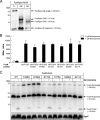Self-cleavage of the Pseudomonas aeruginosa Cell-surface Signaling Anti-sigma Factor FoxR Occurs through an N-O Acyl Rearrangement
- PMID: 25809487
- PMCID: PMC4424355
- DOI: 10.1074/jbc.M115.643098
Self-cleavage of the Pseudomonas aeruginosa Cell-surface Signaling Anti-sigma Factor FoxR Occurs through an N-O Acyl Rearrangement
Abstract
The Fox system of Pseudomonas aeruginosa is a cell-surface signaling (CSS) pathway employed by the bacterium to sense and respond to the presence of the heterologous siderophore ferrioxamine in the environment. This regulatory pathway controls the transcription of the foxA ferrioxamine receptor gene through the extracytoplasmic function sigma factor σ(FoxI). In the absence of ferrioxamine, the activity of σ(FoxI) is inhibited by the transmembrane anti-sigma factor FoxR. Upon binding of ferrioxamine by the FoxA receptor, FoxR is processed by a complex proteolytic cascade leading to the release and activation of σ(FoxI). Interestingly, we have recently shown that FoxR undergoes self-cleavage between the periplasmic Gly-191 and Thr-192 residues independent of the perception of ferrioxamine. This autoproteolytic event, which is widespread among CSS anti-sigma factors, produces two distinct domains that interact and function together to transduce the presence of the signal. In this work, we provide evidence that the self-cleavage of FoxR is not an enzyme-dependent process but is induced by an N-O acyl rearrangement. Mutation analysis showed that the nucleophilic side chain of the Thr-192 residue at +1 of the cleavage site is required for an attack on the preceding Gly-191, after which the resulting ester bond is likely hydrolyzed. Because the cleavage site is well preserved and the hydrolysis of periplasmic CSS anti-sigma factors is widely observed, we hypothesize that cleavage via an N-O acyl rearrangement is a conserved feature of these proteins.
Keywords: Cell Signaling; Gene Regulation; Iron; Post-translational Modification (PTM); Proteolysis; Pseudomonas aeruginosa (P. aeruginosa); Siderophore; Signal Transduction.
© 2015 by The American Society for Biochemistry and Molecular Biology, Inc.
Figures






Similar articles
-
Processing of cell-surface signalling anti-sigma factors prior to signal recognition is a conserved autoproteolytic mechanism that produces two functional domains.Environ Microbiol. 2015 Sep;17(9):3263-77. doi: 10.1111/1462-2920.12776. Epub 2015 Feb 14. Environ Microbiol. 2015. PMID: 25581349
-
Bacterial TonB-dependent transducers interact with the anti-σ factor in absence of the inducing signal protecting it from proteolysis.PLoS Biol. 2024 Dec 2;22(12):e3002920. doi: 10.1371/journal.pbio.3002920. eCollection 2024 Dec. PLoS Biol. 2024. PMID: 39621812 Free PMC article.
-
Different roles for anti-sigma factors in siderophore signalling pathways of Pseudomonas aeruginosa.Mol Microbiol. 2009 Dec;74(5):1257-71. doi: 10.1111/j.1365-2958.2009.06932.x. Epub 2009 Nov 2. Mol Microbiol. 2009. PMID: 19889096
-
Molecular mechanism of ferricsiderophore passage through the outer membrane receptor proteins of Escherichia coli.Biometals. 2007 Jun;20(3-4):263-74. doi: 10.1007/s10534-006-9060-9. Epub 2006 Dec 22. Biometals. 2007. PMID: 17186377 Review.
-
Iron acquisition and its control in Pseudomonas aeruginosa: many roads lead to Rome.Front Biosci. 2003 May 1;8:d661-86. doi: 10.2741/1051. Front Biosci. 2003. PMID: 12700066 Review.
Cited by
-
The role of FoxA, FiuA, and FpvB in iron acquisition via hydroxamate-type siderophores in Pseudomonas aeruginosa.Sci Rep. 2024 Aug 13;14(1):18795. doi: 10.1038/s41598-024-69152-6. Sci Rep. 2024. PMID: 39138320 Free PMC article.
-
Extracellular haem utilization by the opportunistic pathogen Pseudomonas aeruginosa and its role in virulence and pathogenesis.Adv Microb Physiol. 2021;79:89-132. doi: 10.1016/bs.ampbs.2021.07.004. Epub 2021 Aug 13. Adv Microb Physiol. 2021. PMID: 34836613 Free PMC article.
-
Insight into the autoproteolysis mechanism of the RsgI9 anti-σ factor from Clostridium thermocellum.Proteins. 2024 Aug;92(8):946-958. doi: 10.1002/prot.26690. Epub 2024 Apr 10. Proteins. 2024. PMID: 38597224 Free PMC article.
-
RskA Is a Dual Function Activator-Inhibitor That Controls SigK Activity Across Distinct Bacterial Genera.Front Microbiol. 2020 Sep 9;11:558166. doi: 10.3389/fmicb.2020.558166. eCollection 2020. Front Microbiol. 2020. PMID: 33013790 Free PMC article.
-
Mechanistic Implications of the Unique Structural Features and Dimerization of the Cytoplasmic Domain of the Pseudomonas Sigma Regulator, PupR.Biochemistry. 2015 Sep 29;54(38):5867-77. doi: 10.1021/acs.biochem.5b00826. Epub 2015 Sep 14. Biochemistry. 2015. PMID: 26313375 Free PMC article.
References
-
- Ratledge C., Dover L. G. (2000) Iron metabolism in pathogenic bacteria. Annu. Rev. Microbiol. 54, 881–941 - PubMed
-
- Wandersman C., Delepelaire P. (2004) Bacterial iron sources: from siderophores to hemophores. Annu. Rev. Microbiol. 58, 611–647 - PubMed
-
- Poole K., McKay G. A. (2003) Iron acquisition and its control in Pseudomonas aeruginosa: many roads lead to Rome. Front. Biosci. 8, d661–d686 - PubMed
Publication types
MeSH terms
Substances
LinkOut - more resources
Full Text Sources

